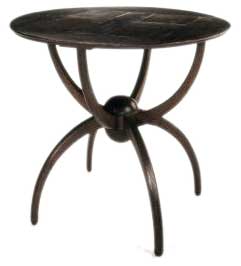
- Source.
- Source for Class and Taste in Edwardian England.
- For more context, sources of ephemera and information: Edwardian Emporium.
- Edwardian Furniture at Ebay.
- Edwardian Sold Lots at Sotheby's
- American Art Metal Jewelry Boxes
For more Edwardian source material, see entry on Edwardian slang, as well as the idiom soaked mystery-writing of P. G. Wodehouse.
Furniture makers and manufacturers in the Edwardian era soon realised that reproductions would outsell anything new or innovative. The Edwardian era was the time that saw the explosion of the antique trade and the habit of buying secondhand furniture for homes, continuing throughout the twentieth century.
 |
| Bamboo Cabinet, 1910 |
While the Arts and Crafts style continued in popularity it rather failed to accomodate itself to the reality of the machine age in the way that European designers managed to and entered into a decline from the early 20th century.
The avant garde furniture movement, called Art Nouveau in France, Jugendstil in Germany, and Stile Liberty in Italy, came to prominence in England in the late nineteenth century and through the Edwardian era it continued to exert an influence although gradually losing vitality.
Avant Garde Furniture
England, the mother of the modern decorative movement, now seems likely to give up the leadership she has so firmly held for twenty years. - "The House is Beautiful", Chicago, 1899
"One of the main designers of Edwardian era avant garde furniture was Charles Rennie Mackintosh. Rennie produced furniture was internationally celebrated and consisted of striking and unorthodox designs.
 |
| Settle, 1916, by Charles Rennie Mackintosh, Painted wood, with fabric upholstery. |
Class and Taste in Edwardian England
The class system in England during the first decade of the 20th century was divided into the upper, middle, and working classes. The lives of the landed gentry and the grinding poverty of working-class life were much the same as before. It was the growing middle class, of which the Colemans and Waterhouses were a part, that changed the most.
The Colemans belonged to the upper middle class, for whom the average household income was £750-1500/year. (By comparison, a working-class cook in one of these households made £30/year, a maid £16-22.) The man of the house was likely to be a merchant, banker, solicitor, physician, surgeon or manufacturer. The household would include 3-7 servants – Kitty Coleman employed a cook, a live-in maid, a gardener and, when her daughter was young, a nanny.
Members of the upper middle class were usually Church of England, Tory, and conservative in outlook. For the most part they were happy to be what they were.
 The Waterhouses belonged to the lower middle class, with an income of £150-500/year. Professions included shopkeepers, office workers, factory foremen, teachers, travelling salesmen, and small businessmen. They did not have the money for live-in help, but often employed a maid-of-all-work called a char.
The Waterhouses belonged to the lower middle class, with an income of £150-500/year. Professions included shopkeepers, office workers, factory foremen, teachers, travelling salesmen, and small businessmen. They did not have the money for live-in help, but often employed a maid-of-all-work called a char.
The writer J.B. Priestley characterized the lower middle class as "narrow, suspicious, carping, mean-souled…[It] lived in the fear of sliding back into the jungles and bogs of the workers. It had achieved respectability and was terrified of losing it." As a result the lower middle class was often quite reactionary.
Class differences were reflected in domestic taste in the early 1900s. Lower middle class families often clung to Victoriana long after the upper middle class had embraced new fashions. Changes in taste affected everything from paint color to curtain fabrics to flowers planted – even to whether windows were left open or not. (Edwardians were great believers in fresh air; Victorians feared drafts.)
In general, differences in domestic taste can be categorized as follows:



No comments:
Post a Comment